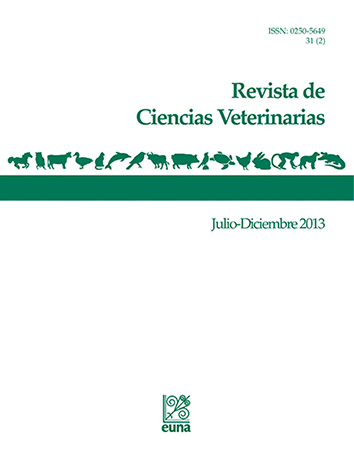Equine sarcoid treatment: Report of four clinical cases
Keywords:
Equine sarcoid, autologous vaccine, PapillomavirusAbstract
Sarcoid is the most common skin tumor in horses, with different presentations and locations on the skin. This study is aimed at describing the presentation, approach and evolution of four clinical cases of equine sarcoid in Costa Rica. The treatment implemented is described, as well as the subsequent evolution of these cases treated with surgical removal, cauterization and autologous vaccine. Two male horses, ages three and six, with lesions in the foreskin and inguinal area, received a combined therapy with surgical removal, cauterization and two doses of autologous vaccine. A third horse, seven years old, with a lesion on the lip, and a mare, eight years old, with a mass in the right forelimb over the radius, were treated with surgical removal and cauterization. Even though all patients developed a favorable clinical response to their treatments, those treated with surgical removal, cauterization and autologous vaccine showed no relapse compared to the other equines that were treated exclusively with surgical removal and cauterization.
References
Bergvall, K. E. 2013. Sarcoids. Vet. Clin. North Am. Equine Pract. 29: 657-671.
Carr, E.A. 2012. Skin conditions amenable to surgery. In: J.A. Auer and J.A. Stick (ed.). Equine surgery. 4 ed. Elservier Saunders, USA. Pp: 327-329.
Carstanjen, B., Jordan, P. & Lepage, O.M. 1997. Carbon dioxide laser as surgical instrument for sarcoid therapy- A retrospective study on 60 cases. Can. Vet. J. 38: 773-776.
Foy, J.M., Rasiimir-Raven, A.M. & Brasiier, M.K. 2002. Common equine skin tumors. Com. Cont. Edu.for the Prac. Vet. 24: 242-253.
Goodrich, L., Gerber, H., Marti, E. & Antczak, D.F. 1998. Equine sarcoids. Vet. Clin. North. Am. Equine. Pract. 14: 607-623.
Jubb, K.V.F., Kennedy, P.C. & Palmer, N. 2007. Pathology of domestic animals. 5 ed. Elservier Saunders, USA.
Knottenbelt, D.C., Edwards, S. & Daniel, E. 1995. Diagnosis and treatment of the equine sarcoid. In. Pract.17: 123-129.
Marais, H.J. & Page, P.C. 2011. Treatment of equine sarcoid in seven cape mountain zebra (Equus zebra zebra) J. Wild. Dis. 47: 917-924.
Marchetti, B., Gault, E.A., Cortese, M.S., Yuan, Z, Ellis, S.A., Nasir, L. & Campo, M.S. 2009. Bovine papillomavirus type 1 oncoprotein E5 inhibits equine MHC class I and interacts with equine MHC I heavy chain. J. Gen. Virol. 90: 2865-2870.
Marti, E., Lazary, S., Antczak, D.F. & Gerber, H. 1993. Report of the first international workshop on equine sarcoid. Equine Vet. J. 25: 397-407.
McMahlan, N.J. & Dubovi, E.J. 2011. Fenner´s Veterinary Virology. 4 ed. Academic Press, Elsevier, USA.
Murphy, F.A., Gibbs, P.J., Horzinek, M.C. & Studdert, M.J. 1999. Veterinary virology. 3 ed. Acad. Press, Elsevier, USA.
Nasir, L. & Brandt, S. 2013. Papillomavirus associated diseases of the horse. Vet Microbiol. 167: 159-167.
Nasir, L. & Saveria, M. C. 2008. Bovine papillomaviruses: Their role in the aetiology of cutaneous tumors of bovids and equids. Jour. Comp. 19: 243-254.
Nasir, L. & Reid, S.W. 1999. Bovine papillomaviral gene expression in equine sarcoid tumors. Virus Res. 61: 171-175.
Reed, S.M., Bayly, W.B. & Sellon, D.C. 2004. Equine internal medicine. 2 ed. Elsevier Saunders, USA.
Sellon, D. C., & Long, M.T. 2014. Equine infectious diseases. P. 246-251. 2 ed. Saunders, U.S.A.
Scott, W.D & Miller, H.W. 2011. Equine dermatology. 9 ed. Elservier Saunders, USA.
Stadler, S., Kainsbauer, C., Haralambus, R., Brehm, W.,Hainisch, E., Brandt, S. 2011. Successful treatment of equine sarcoids by topical acyclovir application. Vet. Rec.168: 187.
Torrontegui, B.O. & Reid, S.W. 1994. Clinical and pathological epidemiology of the equine sarcoid in a referral population. Equine Vet. Educ. 6: 85.
Van der Kolk, J. H. & Veldhuis, E. J. 2013. Infectious diseases of the horse: diagnosis, pathology management and public health. Manson Publishing, U. K.
Wobeser, B.K., Davis, J.L., Hill E.J., Jackson, M.L., Kidney, B.A., Mayer, M.N., Townsend, H.G. & Allen, A.L. 2010. Epidemiology of equine sarcoids in horses in Western Canada. Can. Vet. J. 51:1103–1108
Zachary, J.F. & McGavin, M. D. 2012. P. 1025-1027. Pathologic basis of veterinary disease. 5 ed. Mosby, U.S.A
Zur Hausen, H. 2002. Papillomavirus and cancer form basic studies to clinical application. Nat. Rev. Canc. 2: 342-350.
Downloads
Published
How to Cite
Issue
Section
License
Licensing of articles
All articles will be published under a license:

Licencia Creative Commons Atribución-NoComercial-SinDerivadas 3.0 Costa Rica.
Access to this journal is free of charge, only the article and the journal must be cited in full.
Intellectual property rights belong to the author. Once the article has been accepted for publication, the author assigns the reproduction rights to the Journal.
Ciencias Veterinarias Journal authorizes the printing of articles and photocopies for personal use. Also, the use for educational purposes is encouraged. Especially: institutions may create links to specific articles found in the journal's server in order to make up course packages, seminars or as instructional material.
The author may place a copy of the final version on his or her server, although it is recommended that a link be maintained to the journal's server where the original article is located.
Intellectual property violations are the responsibility of the author. The company or institution that provides access to the contents, either because it acts only as a transmitter of information (for example, Internet access providers) or because it offers public server services, is not responsible.







